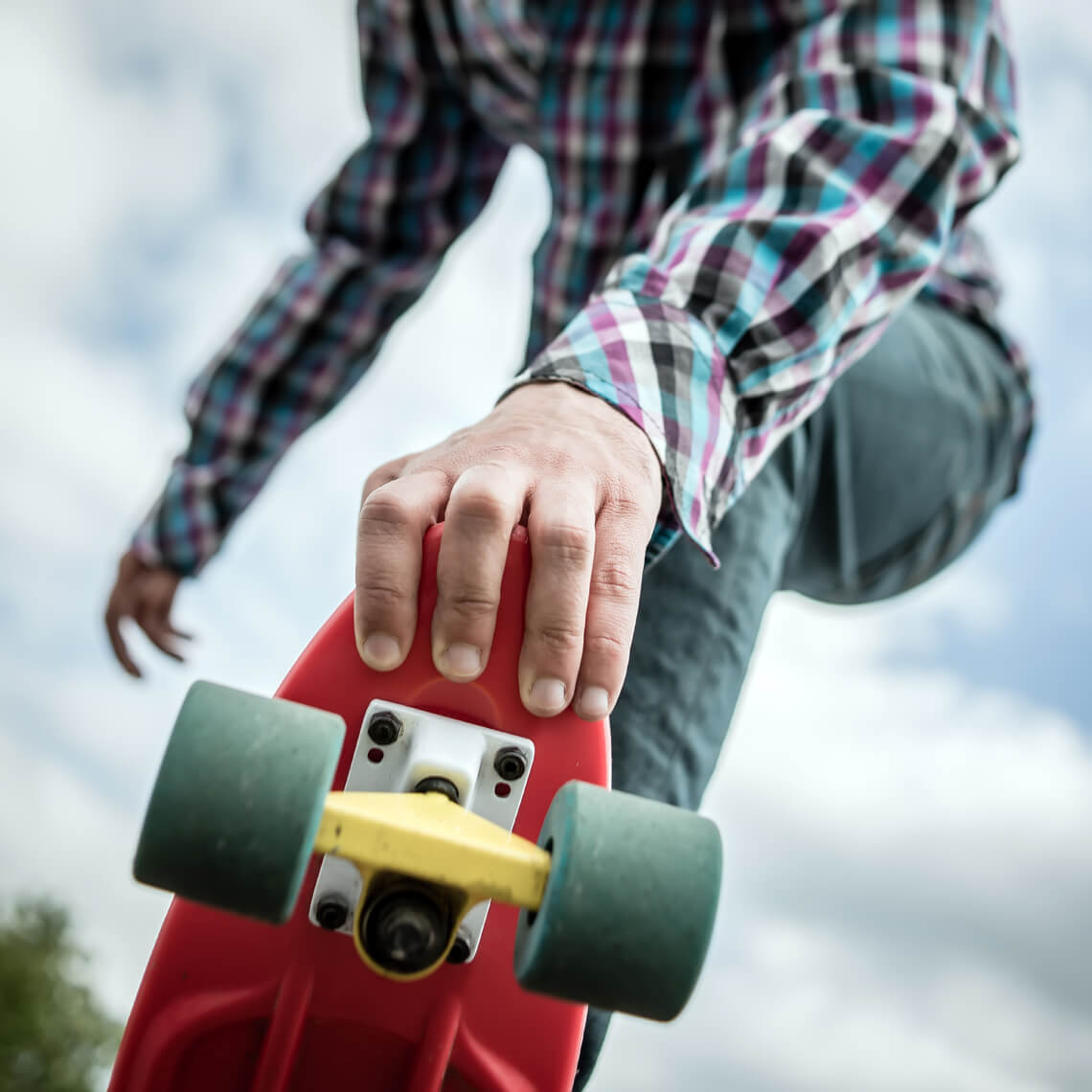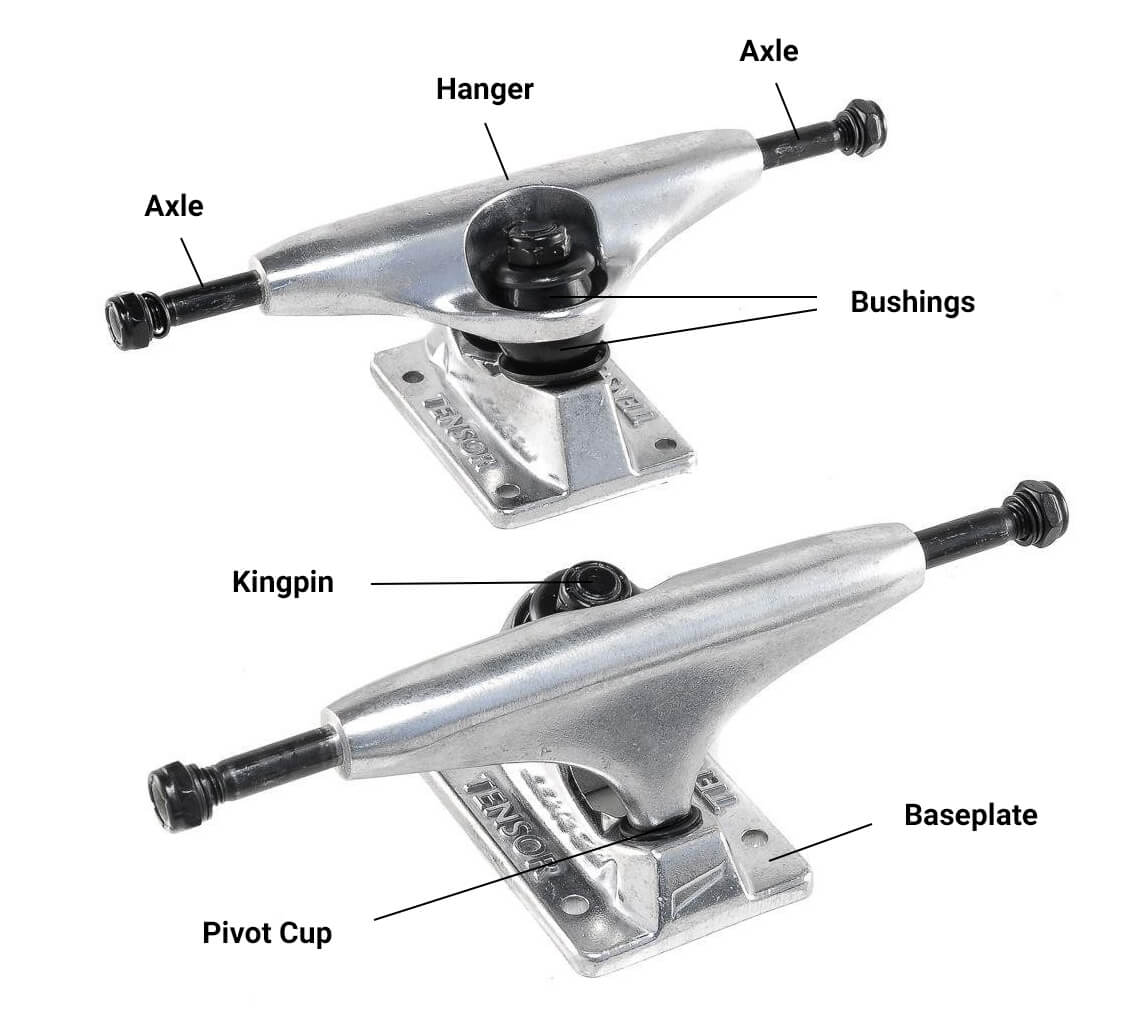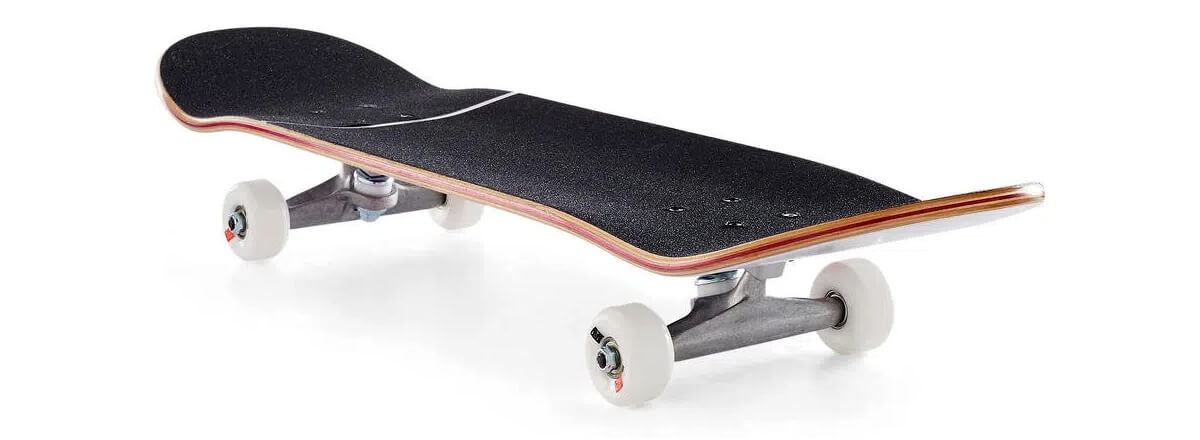What size skateboard should you get? How should you choose your first skateboard? Learn how to buy a deck, a truck, and a set of wheels.
Generally speaking, a skateboard shouldn't be narrower or wider than the length of your feet.
But that's theory. You'll find multiple exceptions depending on your experience level and riding style.
The truth is that each skater has their own favorite setups, depending on their riding style, discipline, and experience level.
Explore the interaction between the different parts of a skateboard before choosing which model to buy.
Take a look at our skateboard size charts. Find the right deck, truck, and wheels for your sidewalk surfing experience.

Skateboard Decks
Remember that just because you're a certain skate shoe size, it doesn't mean you should be a certain size board. It could be a personal preference.
Skinny decks are often associated with easier flip tricks, but they will also break faster.
Adults might feel that tiny skateboards are difficult to control and harder to land tricks. It's like riding a toothpick.
Nevertheless, because they're light, you'll get in the air higher, and they're easy to flick and perform tech tricks.
Skating in a smaller space to stand on will make it hard for you to find your center of balance.
The 8' skateboard is one of the most ridden sizes. It's the perfect deck for the average recreational adult.
Bigger templates, like the 8.5'', are a good option for catching flip tricks and provide more stability. They're heavy skateboards.
Some skaters who ride an 8'' will probably prefer to size up rather than down to 7.5''.
| Micro | Mini | Small | Mid | Full | |
|---|---|---|---|---|---|
| Deck Width (inches/cm) | 6.5''-6.75'' | 7.0'' | 7.3'' | 7.5''-7.6'' | > 7.7'' |
| Age | < 5 (Toddler, Child) | 6-7 (Child) | 8-12 (Child, Teenager) | 13-14 (Teenager) | > 15 (Teenager, Adult) |
| Height (inches/cm) |
< 3'4'' 101.6 cm |
3'5''-4'4'' 104-132 cm |
4'5''-5'2'' 134-157 cm |
5'3''-5'8'' 160-172 cm |
> 5'7'' > 170 cm |
| Shoe Size (US/EU/UK) |
0-3 (US) 0-35 (EU) 0-2.5 (UK) |
4-5 (US) 36-37.5 (EU) 3.5-4.5 (UK) |
6-7 (US) 38-39.3 (EU) 5-6 (UK) |
7-8 (US) 39.3-40.5 (EU) 6-7 (UK) |
> 9 (US) > 42 (EU) > 8 (UK) |
Skateboard Trucks
Trucks are responsible for connecting and making the bridge between the skateboard and the wheels.
In order to choose the right trucks, you need to understand how they work, what their components are, and how their size, profile/height, and width affect the riding.
A skateboard truck comprises six main parts: the baseplate, the pivot cup, the bushings, the kingpin, the hanger, and the axle.
Most modern skate trucks are made of solid or hollow aluminum baseplates and hangers, and steel axles.
Some skateboard manufacturers will also incorporate and blend parts made from titanium and magnesium.
And because skateboards must carve, turn and absorb high impacts, they also feature bushings, a polyurethane - or silicone - a piece that serves as an interface between the board and the wheels.
There are three types of bushings: soft (< 92a), medium (92a-97a), and hard bushings (98a +).
A soft bushing is the best choice for light skaters, longboarders, and cruisers who need their boards to turn faster.
On the opposite side of the spectrum, hard bushings are a highly responsive option for technical and street skaters who seek board control.
The kingpin is a critical piece. It is a large bolt connecting the hanger to the baseplate and works as the truck's backbone.
In other words, it controls the pressure put on the bushing, so a skater can quickly tighten it by turning the bolt to the right or loosen it by turning it to the left.
They can break quite often but can also be replaced easily.
The pivot cup is a rounded plastic part that sits on the baseplate. When it wears down, it makes the truck unstable.

Width
Two parts can be measured to determine the recommended truck width - the length of the axle and the length of the hanger.
Unfortunately, there is no standard measurement for both components. Each truck company adopted its own sizing system.
The hanger is the largest part of the skateboard truck. It's the triangular metal piece that supports the axle and allows skaters to grind on curbs, rails, and ramps.
The axle is the long pin that runs through the hanger and attaches to the wheels. It is measured from bolt to bolt.
As a general rule of thumb, both ends of the axle should line up to the sides of your skateboard.
Profile/Height
The skateboard truck profile is the distance between the bottom of the skate deck and the hanger.
As a result, there are high, mid, and low trucks.
Low trucks are designed to provide extra stability for technical skating maneuvers, for example, flip tricks. They should be used with small wheel sizes in the 50-to-53-millimeter range.
Mid-level trucks are an all-around pick for street and park skateboarding, so they will require wheels in the 53-to-56-millimeter range.
High trucks are the best option for longboarders and cruisers seeking to carve and ride comfortably across the streets. They should be used with 56-millimeter-plus wheels.
| Truck Manufacturers | Size | Type | Height | Hanger Width | Axle Width | Recommended Truck Width |
|---|---|---|---|---|---|---|
| Ace | 22 Classic 5.0'' | Mid | 52 mm | 5'' (127 mm) | 7.6'' (193 mm) | 7'' - 7.75'' |
| 03 Low 5.375'' | Low | 48 mm | 5.375'' (136 mm) | 8'' (203 mm) | 7.75'' - 8.125'' | |
| 33 Classic 5.375'' | Mid | 52 mm | 5.375'' (136 mm) | 8'' (203 mm) | 7.75'' - 8.125'' | |
| 44 Classic 5.75'' | Mid | 52 mm | 5.75'' (146 mm) | 8.35'' (212 mm) | 8.125'' - 8.5'' | |
| 55 Classic 6.375'' | Mid | 52 mm | 6.375'' (162 mm) | 9'' (229 mm) | 8.5'' - 9.12'' | |
| Destructo | 5.25 Low | Mid | 50 mm | 5.25'' (133 mm) |
8'' (202 mm) |
7.875'' - 8.125'' |
| 5.25 Mid | High | 56 mm | 5.25'' (133 mm) | 8'' (202 mm) | 7.875'' - 8.125'' | |
| Independent | 129 Low | Low | 48 mm | 5.0'' (128 mm) | 7.625'' (194 mm) | 7.375'' - 7.75'' |
| 129 Standard | High | 55 mm | 5.0'' (128 mm) | 7.625'' (194 mm) | 7.375'' - 7.75'' | |
| 139 Low | Low | 48 mm | 5.39'' (137 mm) | 8'' (203 mm) | 7.875'' - 8.125'' | |
| 139 Standard | High | 55 mm | 5.39'' (137 mm) | 8'' (203 mm) | 7.875'' - 8.125'' | |
| 144 Standard | High | 55 mm | 5.625'' (143 mm) | 8.25'' (209 mm) | 8.125'' - 8.375'' | |
| 149 Standard | High | 55 mm | 5.9'' (150 mm) | 8.5'' (216 mm) | 8.375'' - 8.625'' | |
| 159 Standard | High | 55 mm | 6.15'' (156 mm) | 8.75'' (222 mm) | 8.625'' - 8.875'' | |
| 169 Standard | High | 55 mm | 6.5'' (160 mm) | 9.125'' (232 mm) | 9'' - 9.25'' | |
| 215 Standard | High | 55 mm | 7.36'' (187 mm) | 10'' (254 mm) | 9.75'' - 10.25'' | |
| Polster | 4.5 Standard | Mid | 52 mm | 4.5'' (114 mm) | 7.125'' (181 mm) | 6.875'' - 7.375'' |
| 5.0 Standard | Mid | 50 mm | 5.0'' (127 mm) | 7.64'' (195 mm) | 7.5'' - 7.75'' | |
| 5.25 Standard | Mid | 52 mm | 5.25'' (134 mm) | 7.875'' (200 mm) | 7.75'' - 8.0'' | |
| 5.5 Standard | Mid | 52 mm | 5.5'' (140 mm) | 8.125'' (206 mm) | 8.0'' - 8.25'' | |
| 5.85 Standard | Mid | 52 mm | 5.9'' (150 mm) | 8.5'' (216 mm) | 8.375'' - 8.625'' | |
| Tensor | 5.0 Low | Low | 46 mm | 5.0'' (127 mm) | 7.625'' (197 mm) | 7.5'' - 7.75'' |
| 5.25 Low | Low | 46 mm | 5.25'' (133 mm) | 8'' (202 mm) | 7.875'' - 8.125'' | |
| 5.25 Regular | Mid | 52 mm | 5.25'' (133 mm) | 8'' (202 mm) | 7.875'' - 8.125'' | |
| 5.5 Low | Low | 46 mm | 5.5'' (140 mm) | 8.125'' (207 mm) | 8'' - 8.25'' | |
| 5.5 Regular | Mid | 52 mm | 5.5'' (140 mm) | 8.125'' (207 mm) | 8'' - 8.25'' | |
| 5.75 Regular | Mid | 52 mm | 5.75'' (146 mm) | 8.375'' (213 mm) | 8.25'' - 8.5'' | |
| 6.0 Regular | Mid | 52 mm | 6'' (152 mm) | 8.625'' (219 mm) | 8.5'' - 8.75'' | |
| Thunder | 143 | Mid | 50 mm | 4.5'' (115 mm) | 7.125'' (181 mm) | 6.875'' - 7.375'' |
| 145 Low | Low | 47 mm | 5.0'' (128 mm) | 7.625'' (194 mm) | 7.375'' - 7.75'' | |
| 145 High | Mid | 50 mm | 5.0'' (128 mm) | 7.625'' (194 mm) | 7.375'' - 7.75'' | |
| 147 High | Mid | 50 mm | 5.39'' (137 mm) | 8'' (203 mm) | 7.875'' - 8.125'' | |
| 148 High | Mid | 50 mm | 5.67'' (144 mm) | 8.25'' (210 mm) | 8.125'' - 8.375'' | |
| 149 High | Mid | 52 mm | 5.9'' (150 mm) | 8.5'' (216 mm) | 8.375'' - 8.625'' | |
| 151 High | Mid | 52 mm | 6.15'' (156 mm) | 8.75'' (222 mm) | 8.625'' - 8.875'' | |
| Venture | 5.0 Low | Low | 48 mm | 5.0'' (128 mm) | 7.625'' (194 mm) | 7.5'' - 7.75'' |
| 5.0 High | High | 53.5 mm | 5.0'' (128 mm) | 7.625'' (194 mm) | 7.5'' - 7.75'' | |
| 5.25 Low | Low | 48 mm | 5.39'' (137 mm) | 8'' (203 mm) | 7.875'' - 8.125'' | |
| 5.25 High | High | 53.5 mm | 5.39'' (137 mm) | 8'' (203 mm) | 7.875'' - 8.125'' | |
| 5.8 High | High | 53.5 mm | 5.9'' (150 mm) | 8.5'' (216 mm) | 8.375'' - 8.625'' |
Skateboard Wheels
Skateboard wheels come in many different sizes and shapes.
Three main variables come into play when choosing the best set of wheels for your skateboard and riding style: diameter, contact patch, profile or shape, and hardness or durometer.
The trick is to experiment with different wheel sizes and shapes to figure out what works best for you.
| Skateboard Wheel Diameter | Skateboarding Style |
|---|---|
| 49 mm - 52 mm | Technical Skateboarding |
| 52 mm - 55 mm | All Around and Street Skateboarding |
| 55 mm - 60 mm | Street Skateboarding |
| 60 mm - 65 mm | Cruising and Transportation |
| 65 mm - 70 mm | Longboarding |
| 70 mm + | Downhill Racing |
Diameter
Diameter is the most important characteristic of a skateboard wheel. It's the dimension that determines the wheel size.
Contact Patch
The contact patch, also known as the riding surface, is the area of the wheel that rolls on the ground.
The wider the contact patch, the more grip you'll have on the ground.
Profile or Shape
The profile - or shape - of the wheel will also have an impact on the riding experience.
Wheels with a rounder lip will help you roll over coping, while flat-sided models will help you lock into grinds.
Hardness or Durometer
Skateboard wheels are made of cured polyurethane.
The Shore A Scale measures the hardness of flexible mold rubbers.
The hardness or durometer of a skateboard wheel ranges on a scale from 74a (very soft) to 104a (extremely hard).
The hardness affects the way it skates across the ground.
Soft wheels give the skater a lot of grip and will cushion bumpy and irregular terrains and pavements. They're the go-to option of cruisers, longboarders, and anyone using skateboards for transportation.
Hard wheels are more slippery, offer less grip, and are often chosen by riders wishing to perform tricks, pivot, and slide in skateparks and street skateboarding.
| Skateboard Wheel Hardness/Durometer | Riding Characteristics | Skateboarding Style |
|---|---|---|
| 78a - 87a | Soft Wheel, High Grip, Comfort Riding, Slow, Non-Reactive, Fast Wear | Downhill Racing and Longboarding |
| 88a - 95a | Medium Soft Wheel, Good Grip, Cushioned Ride, Average Speed, Slightly Reactive, Medium Wear | Cruising and Transportation |
| 96a - 101a | Medium Hard Wheel, Average Grip, Cushioned Ride, Moderately Fast, Moderately Reactive, Medium Wear | Street and Park Skateboarding |
| 101a + | Hard Wheel, Poor Grip, Sensitive Ride, Super Fast, Highly Reactive, Slow Wear | Technical, Street and Park Skateboarding |
Types of Wheels
There are three types of skateboard wheels: street and park wheels, cruiser wheels, and longboard wheels.
Street/Park Wheels
Street and park wheels are lightweight, easy to slide and roll fast on flat, smooth surfaces. As a result, they make things easier for skaters to perform ollies, power slides, flip tricks, and technical skating.
They range from 50 to 60 millimeters in diameter and between 95 and 101a in hardness or durometer.
Cruiser/Soft Wheels
Cruiser or soft skateboard wheels, also known as filmer wheels - are softer and slightly bigger than park and street wheels.
They can be used in almost any skateboard deck and excel on nearly any surface, be it smooth or rough pavement or terrain.
They range from 54 to 60 millimeters in diameter and between 78 and 90a in hardness or durometer.
Longboard Wheels
Longboard wheels are the largest models available. They were designed to keep the grip through all corners and roll fast on rough and irregular surfaces.
These wheels have many carving, sliding, cruising, and downhill racing options.
They range from 60 to 75 millimeters in diameter and between 75 and 85 in hardness or durometer.

